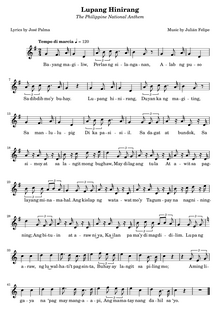
Back نشيد الفلبين الوطني Arabic نشيد الفلبين الوطنى ARZ Filippin himni Azerbaijani Lupang Hinirang BBC Lupang Hinirang BCL Гімн Філіпінаў Byelorussian Lupang Hinirang BS Lupang Hinirang Catalan Lupang Hinirang CBK-ZAM Nasodnong Awit sa Pilipinas CEB
| English: "Chosen Land" | |
|---|---|
 Music sheet of "Lupang Hinirang" | |
National anthem of the Philippines | |
| Also known as | "Marcha Nacional Filipina" (original title of the march composed by Julián Felipe) "Filipinas" (original title of the poem written by José Palma) |
| Lyrics | José Palma (original Spanish lyrics), 1899 Felipe Padilla de León (Tagalog lyrics), 1956 |
| Music | Julián Felipe, 1898 |
| Adopted | |
| Audio sample | |
The Philippine national anthem, "Lupang Hinirang" | |
"Lupang Hinirang" ("Chosen Land"), originally titled in Spanish as "Marcha Nacional Filipina" ("Philippine National March"), and commonly and informally known by its incipit "Bayang Magiliw" ("Beloved Country"), is the national anthem of the Philippines. Its music was composed in 1898 by Julián Felipe, and the lyrics were adopted from the Spanish poem "Filipinas", written by José Palma in 1899.[2]
The composition known as "Lupang Hinirang" was commissioned on June 5, 1898, by Emilio Aguinaldo, head of the Dictatorial Government of the Philippines,[2] as a ceremonial and instrumental national march without lyrics, similar to the status of the "Marcha Real" in Spain. It was first performed in public during the proclamation of Philippine independence at Aguinaldo's residence in Kawit, Cavite, on June 12, 1898. It was re-adopted as the national march of the Philippine Republic (Spanish: República Filipina) in 1899.
Following the defeat of the First Republic in the Philippine–American War and the subsequent Colonial rule of the United States, the Flag Act of 1907 prohibited the public display of flags, banners, emblems, or devices used by the Philippine Republican Army during the war.[1] Under the Flag Act, public performance of the national march was prohibited.[3][failed verification] Upon repeal of the Flag Act in 1919, the national march regained its popular status as the national anthem of the Philippines.[citation needed] Following the establishment of self-rule under the Commonwealth of the Philippines, Commonwealth Act No. 382, approved on September 5, 1938, officially adopted the musical arrangement and composition by Julián Felipe as the national anthem.[4]
In the years after the revolution, the poem "Filipinas", written in 1899 by nationalist José Palma, gained widespread popularity as unofficial Spanish lyrics of the anthem. The Spanish lyrics were translated into English and, beginning in the 1940s, in the national language. The current Filipino lyrics, written in 1956 and with a slight revision in the 1960s, were adopted and made official.[5] On February 12, 1998, Republic Act No. 8491 was passed, codifying these lyrics into law.[1]
- ^ a b c Cite error: The named reference
ra8491was invoked but never defined (see the help page). - ^ a b "About The Philippine National Anthem". philembassy.org.au. Retrieved July 23, 2020.
- ^ Pomeroy, William J. (1992). The Philippines: Colonialism, Collaboration, and Resistance. International Publishers Co. p. 10. ISBN 0-7178-0692-8. Retrieved January 26, 2008.
Philippines flag law.
; excerpted quote: "In 1909 an entire band was sent to prison for playing the Philippine National Anthem at a festival in Quiapo, Manila.", citing Agoncillo, Teodoro A. (2005). The Revolt of the Masses: The Story of Bonifacio and the Katipunan. Quezon City: University of the Philippines Press. - ^ "Commonwealth Act No. 382". Official Gazette of the Philippine Government. September 5, 1938.
- ^ "The History of Lupang Hinirang – The Story of Us | Kapampangan Media". kapampangan.org. May 31, 2020. Retrieved April 9, 2023.